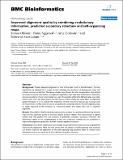| dc.contributor.author | Ohlson, Tomas | |
| dc.contributor.author | Aggarwal, Varun | |
| dc.contributor.author | Elofsson, Arne | |
| dc.contributor.author | MacCallum, Robert M. | |
| dc.date.accessioned | 2010-09-28T20:06:42Z | |
| dc.date.available | 2010-09-28T20:06:42Z | |
| dc.date.issued | 2006-07 | |
| dc.date.submitted | 2006-04 | |
| dc.identifier.issn | 1471-2105 | |
| dc.identifier.other | PMCID: PMC1562450 | |
| dc.identifier.uri | http://hdl.handle.net/1721.1/58739 | |
| dc.description.abstract | Background Protein sequence alignment is one of the basic tools in bioinformatics. Correct alignments are required for a range of tasks including the derivation of phylogenetic trees and protein structure prediction. Numerous studies have shown that the incorporation of predicted secondary structure information into alignment algorithms improves their performance. Secondary structure predictors have to be trained on a set of somewhat arbitrarily defined states (e.g. helix, strand, coil), and it has been shown that the choice of these states has some effect on alignment quality. However, it is not unlikely that prediction of other structural features also could provide an improvement. In this study we use an unsupervised clustering method, the self-organizing map, to assign sequence profile windows to "structural states" and assess their use in sequence alignment. Results The addition of self-organizing map locations as inputs to a profile-profile scoring function improves the alignment quality of distantly related proteins slightly. The improvement is slightly smaller than that gained from the inclusion of predicted secondary structure. However, the information seems to be complementary as the two prediction schemes can be combined to improve the alignment quality by a further small but significant amount. Conclusion It has been observed in many studies that predicted secondary structure significantly improves the alignments. Here we have shown that the addition of self-organizing map locations can further improve the alignments as the self-organizing map locations seem to contain some information that is not captured by the predicted secondary structure. | en_US |
| dc.description.sponsorship | Naturvetenskapliga forskningsrådet (Sweden) | en_US |
| dc.publisher | BioMed Central Ltd | en_US |
| dc.relation.isversionof | http://dx.doi.org/10.1186/1471-2105-7-357 | en_US |
| dc.rights | Creative Commons Attribution | en_US |
| dc.rights.uri | http://creativecommons.org/licenses/by/2.0 | en_US |
| dc.source | BioMed Central Ltd | en_US |
| dc.title | Improved alignment quality by combining evolutionary information, predicted secondary structure and self-organizing maps | en_US |
| dc.type | Article | en_US |
| dc.identifier.citation | Ohlson, Tomas et al. “Improved alignment quality by combining evolutionary information, predicted secondary structure and self-organizing maps.” BMC Bioinformatics 7.1 (2006): 357. | en_US |
| dc.contributor.department | Massachusetts Institute of Technology. Department of Electrical Engineering and Computer Science | en_US |
| dc.contributor.mitauthor | Aggarwal, Varun | |
| dc.relation.journal | BMC Bioinformatics | en_US |
| dc.eprint.version | Final published version | en_US |
| dc.identifier.pmid | 16869963 | |
| dc.type.uri | http://purl.org/eprint/type/JournalArticle | en_US |
| eprint.status | http://purl.org/eprint/status/PeerReviewed | en_US |
| dc.date.updated | 2010-09-03T16:22:50Z | |
| dc.language.rfc3066 | en | |
| dc.rights.holder | Ohlson et al.; licensee BioMed Central Ltd. | |
| dspace.orderedauthors | Ohlson, Tomas; Aggarwal, Varun; Elofsson, Arne; MacCallum, Robert M | en |
| mit.license | PUBLISHER_CC | en_US |
| mit.metadata.status | Complete | |
